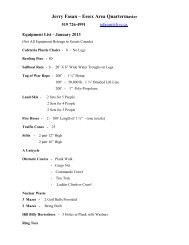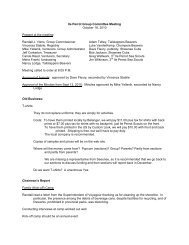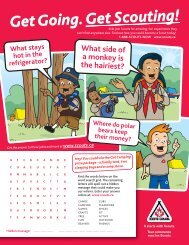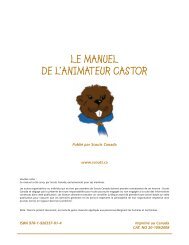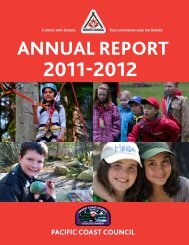Beaver Leader's Handbook - Scouts Canada
Beaver Leader's Handbook - Scouts Canada
Beaver Leader's Handbook - Scouts Canada
You also want an ePaper? Increase the reach of your titles
YUMPU automatically turns print PDFs into web optimized ePapers that Google loves.
Belonging<br />
Perhaps the most important function of lodges is that they provide a feeling of belonging. The<br />
lodge is a “family,” complete with a name and older and younger friends. A healthy feeling of<br />
belonging can help <strong>Beaver</strong>s develop empathy and a capacity to understand other <strong>Beaver</strong>s’<br />
points of view.<br />
Studies have shown that physical appearance (such as size and attractiveness) can influence peer<br />
acceptance. Studies have also shown that children as young as four years old can discriminate on<br />
the basis of race. Through lodges, <strong>Beaver</strong>s learn to see people’s differences as something positive;<br />
they begin to understand that everyone brings special skills and abilities to the lodge.<br />
Activities that strengthen lodge identity and promote social interaction and sharing help build<br />
a sense of belonging in <strong>Beaver</strong>s.<br />
Trust<br />
When <strong>Beaver</strong>s feel they belong to a lodge and the overall colony, it enhances their<br />
sense of trust. Trust is very important in developing friendships, listening to leaders,<br />
and accepting new or changing experiences.<br />
<strong>Beaver</strong>s are more likely to approach new situations eagerly in a lodge environment<br />
that gives them a sense of safety and security. You can build trust by encouraging<br />
<strong>Beaver</strong>s to help one another, share and play together cooperatively in lodge activities.<br />
Initiative<br />
Finally, when the lodge provides a sense of belonging and trust, it gives <strong>Beaver</strong>s the support<br />
base that enables them to risk striking out on their own. You see this when <strong>Beaver</strong>s begin to<br />
talk more, and share their ideas. Enhance the feeling by being an active and interested listener.<br />
It shows you consider each <strong>Beaver</strong> a unique and special person.<br />
Cheer on <strong>Beaver</strong> attempts at trying new things. It helps them to cope with guilt feelings that<br />
may come from fear and fumbling. A pat on the back and praise after a good try are great initiative<br />
builders.<br />
Tail groupings provide <strong>Beaver</strong>s with a healthy sense of competence in their abilities. Lodge activities<br />
provide opportunities to promote feelings of belonging, trust and initiative. Use both kinds<br />
of groups. Together, tails and lodges provide a well-rounded growing experience for children.<br />
CHOOSING A LODGE PATCH<br />
7-4<br />
When choosing a lodge patch, <strong>Beaver</strong>s and leaders have many options to consider. Lodges can<br />
opt to make a felt lodge patch based on the <strong>Beaver</strong>s’ ideas and preferences. This choice provides<br />
opportunities for creative ideas and craft activity. As well, it builds lodge unity.<br />
If the felt becomes worn because of normal play, lodges can make a brand new patch. <strong>Beaver</strong>s<br />
may even choose to give it a different design because their ideas have changed as they’ve developed.<br />
Instead of felt, you might decide to use polyester or another long-wearing fabric.<br />
With the growth in emblem and crest technology, some <strong>Beaver</strong>s may prefer an embroidered<br />
lodge patch. An embroidered animal crest provides opportunities to link the lodge to nature,<br />
Friends of the Forest, and the <strong>Beaver</strong> Promise.



